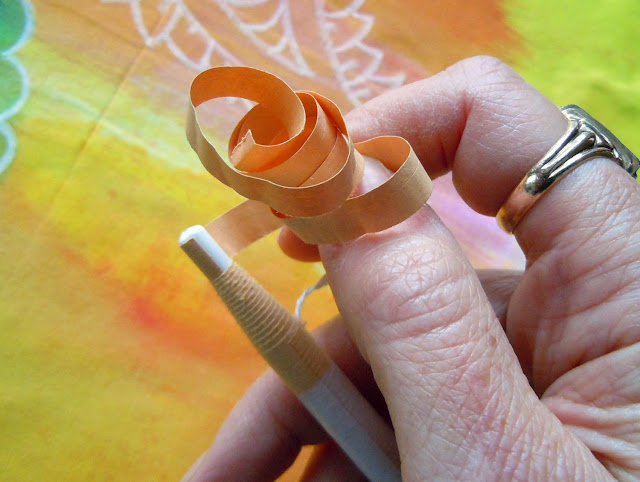So why pencil versus china marker? Simply, pencil will give you a thinner defined line and the china marker a thicker heavier line.
In this case brand does matter. The first sample, if you can see it, was written with a Blick store brand white colored pencil and the second was a Berol Prismacolor white pencil. The Blick pencil was not as creamy and waxy and did not create a very good resist, the ink painted right over it.
If you are unfamiliar with china markers, they are a pencil that can write on a non-porous surface, like plastic, glass or metal and then can be wiped of with a firm rub with a dry cloth.
You don't sharpen them, instead you peel back the paper wrap covering by grasping that little string and pulling it back to the first perforated row
grab the paper, unwind it
then draw.
This is a sample I worked on in the acrylic inks class, layering up multiple different techniques.
The thick white lines are textile paint, the thinner flower vine pattern in the center of the paisley is china marker.The little pale blue crosses in the background were also drawn with white china marker and then painted over with blue ink. I like how they show up really well and have a hint of blue.
I painted over the center of the paisley with red ink.
The pencil does not penetrate the fibers like a gutta resist, so if you have a lot of ink on your brush and the fabric gets really wet it will bleed beyond the pencil lines, but the white lines of the drawn imagery will show through, which to me is the effect I really like.
I painted inside the flowers and leaves with red-violet ink to make them stand out more. The benefit of the china marker was that I could quickly add color without being too fussy and neat because it kept the ink fairly contained.
Voila!















Ooh I love, love this technique. This will help me follow my vow to use what I have on hand. The results are beautiful.
ReplyDeleteMaravillosa técnica!
ReplyDeleteMás adelante me gustaría probarla.
Abrazos!
Really nice technique and something most of us can do.
ReplyDeleteI do have white pencils, will have to see what ones work, but i like the idea of using a china marker.
Debbie
LOVE this! who knew pencils/china markers would resist. Gorgeous paisley too. I REALLY love this! thanks Judy!
ReplyDeleteThank you for sharing this lovely and colorful technique!
ReplyDeleteVery inspiring!
oxo
Thank you!! I shall have to try this out.
ReplyDeleteI will have to get me a china marker and use it on my next project. Thank you for sharing. This looks simple to do and I have just the right project to play with. Thanks for sharing...Judith, Texas
ReplyDeleteHow wonderful! Thanks for sharing
ReplyDeleteQuestion: Does the china marker leave anything on the fabric that's noticeable or wash out?
ReplyDeleteThanks!
Thank u Judy this is wonderful cant wait to try it...
ReplyDeletehugz bev
Such a clever idea! Thank you so much for sharing it.
ReplyDeleteI learn so much on your blog - thank you for sharing your wisdom :-)
ReplyDeleteOoh, this is just my kind of technique! I have a similar question to Threadhead - does the white china maker leave white pigment on/in the fabric? I was thinking about the idea of using it as a resist on fabric that's been dyed, but wasn't sure if the china marker or pencil itself would interfere with the existing color... Guess I'll have to do some tests!
ReplyDelete~~~the Art of Inclusion~~~
Threadhead, the china marker is like drawing on the fabric with a colored pencil or crayon. It marks the surface of the fabric. It doesn't leave a residue that would brush off if that's what you mean.
ReplyDeleteStella and Threadhead to answer in regards to washout or dyeing with this technique, it's not a true resist like gutta or hot wax, it does not thoroughly penetrate the fibers (like you would need for dye), it merely sits on top so when the inks are painted over the marks it creates a nice effect.
It may do some interesting things with dye, but I think the results would be pretty subtle.
Many of the techniques I use may not stand up to 'wash out', I never intend to wash the fabric I create since I make it for art quilts. Even the acrylic inks I would not recommend using if you are planning on washing your fabric. Textile paints are more durable and permanent.
Too cool!Looks like I'll have to get out my inks and play... :)
ReplyDeleteBrilliant! must go buy a china white pencil now lol
ReplyDeleteVery cool! I think I need to get me one of these!
ReplyDeleteHi Judy,
ReplyDeleteLove your work! My friend Delia and I tried your technique today and posted about it on our new blog. May we suggest trying white correction fluid pens? They are easy to work with and the results are sharp and clear!
Check out our experiments at http://avirgothing.blogspot.com.
Leslie
Fabulous!!!! What a great tutorial!!! Thanks for sharing!
ReplyDeleteAMAZING!!! :)
ReplyDeleteHi Judy,
ReplyDeleteNice technique! Love your work!